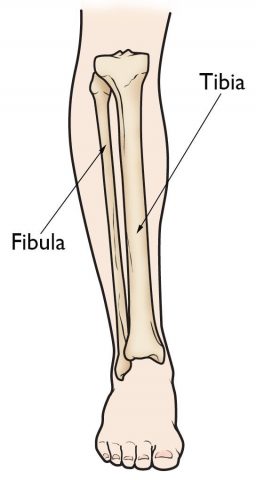Not By the Hairs of My Shinny Shin Shins
Not By the Hairs of My Shinny Shin Shins
Common Running Injuries – Part 2
Welcome back, we’ve missed you! This is part 2 of our common running injuries series. Today we will be focusing on shin splints! Also known as Medial Tibial Stress Syndrome (MTSS).
When you hear shin splints, you probably think “that bone on the front of my lower leg”. But did you know that within the term “shin splints” there are actually several reasons that can cause discomfort and pain in the shins?
Let’s discuss what the different causes may be, what to look for, how we can reduce the likelihood of this condition happening to you, and physical rehab for shin splints.
What are Shin Splints?
In order to make the structures involved with shin splints clear, a quick anatomy lesson is required.

The lower leg consists of several muscles, tissues, nerves, and many other components. For the sake of simplicity, we will be focusing on the tibia and fibula seen in the above picture. The most common area for shin splints and pain, is the inner part of the lower leg or medial aspect of the tibia.
There are many structures that may cause pain at the front of the lower leg. More common than not, the blame is attributed to the bone itself, with rest being the main prescription for reducing pain. However, this may not always be the most appropriate in optimizing recovery.
Shin splints is more of an umbrella term encompassing various causes of pain in the shin region. Listed below are the most common causes of lower leg pain around the shins and what they are defined as.
Periostitis: Inflammation of the periosteum - the layer of connective tissue surrounding the bone. Typically caused by chronic, repetitive pulling of the periosteum by muscles connected to the tissue. When the muscle contracts, it will pull on the periosteum. An example of this would be when your lower leg muscles flex/contract during running, causing increased traction force on the periosteum. Symptoms may include:
- initial soreness with running, but eases during the run (as the muscles warm up).
- Pain when touching the medial border of the tibia that is the exact pain experienced when running, usually an area larger than 5cm in size.
Stress Fracture: This may sound scary but the actual amount of injury is miniscule. Stress fractures are essentially microdamage to the bone as a result of repetitive loading to a certain area (in this case, the tibia). Symptoms may include:
- Diffuse pain around the shin bone.
- Localized pain reproduced on palpation.
Compartment Syndrome: This is the least common cause and is actually very rare. If you have any concerns about compartment syndrome, contact a physiotherapist or local health professional for an appropriate assessment. Certain fascial compartments of the lower leg have too much pressure due to swelling. This then leads to painful cramping sensations. This is commonly treated with operations called fasciotomies which release pressure. Symptoms may include:
- Numbness, tingling
- Intense pain
- Burning sensation that comes on suddenly in the lower leg with running or during exercise
Although these are some common symptoms to look out for, it is important to keep in mind that not everyone will present in the same manner. If you have any questions or concerns, contact a qualified health care professional to provide appropriate diagnosis, treatment, and advice.
Common Causes of Shin Splints
- Sudden increase in activity and training regime (overload)*
- Training time (increased duration)
- Change in running environment (surfaces)
- Change in footwear
- Change in intensity
- Lots of running in general
- High impact sports e.g. basketball, soccer, volleyball
How do we treat Shin Splints (MTSS)?
Appropriate rehabilitation professionals such as Physiotherapists and Chiropractors may provide education, soft tissue treatment, joint mobilizations, taping, specific exercises, and many other options to target your lower leg pain.
The current evidence suggests appropriate load management to be the best treatment for shin splints. Exercises to increase both endurance and strength in the surrounding lower leg muscles has previously been found to be helpful but is not a guarantee to improve symptoms. A combination of progressive loading, alongside exercises for the lower limb to assist with force absorption, appears to be the best in promoting recovery of shin splints!
Taping is also another quite helpful tool to help ease pain as you return to running longer distances. Check out this video here.
Exercises to Help With Shin Splints
Listed below are some exercises for shin splints, based off the most recent rehabilitation evidence and research:
Week 1 – 2 Exercises
Aim for 2 sets and 8 to 12 reps of each exercise. *It is important to stay within your limitations and comfort levels. Start slow and if you are unsure, make sure you check with a qualified healthcare professional like a physiotherapist.
Step Ups
Ecc DL Heel Raise
Soleus Squat
Week 3 – 5 Exercises
Aim for 2 sets and 8 – 12 reps of the first three exercises and 10 reps for the weighted DB heel raises.
DF Marches
Hip Wall Iso Holds
SL Soleus Glute Bridge
Weighted DB Heel Raises
The exercise intensity should be progressed gradually over several weeks. The above program is only an example and you can adjust it to suit your needs. Try and find an intensity that works, a good rule of thumb is that you should be able to do 3-4 more reps at the end of each set if you had to!
Give these a try at home, they just might help you reduce your pain! Begin with low volumes of exercise, 2-3x a week, to allow your body to adjust. Especially if you are not used to doing these movements (see under exercises for repetitions and sets).
(As always it is important to stay within your limitations and comfort levels. Start slow and if you are unsure, make sure you check with a qualified healthcare professional).
To recap, Shin Splints (aka MTSS) is a very common and treatable condition. I hope all you athletes, weekend warriors, and runners found this information useful! If you have any further questions, feel free to contact us or check out our social media for more exercise tips. Thanks for tuning in!
About the Author
Jason Chung, MSc PT, BKin, NSCA-CSCS
Email: jason@strivehealthandperformance.ca
Instagram: @Jchungphysio + @strive_health

Jason Chung is an Interim Physiotherapist and NSCA certified strength and conditioning coach at Strive Health and Performance. Jason is currently pursuing advanced training in musculoskeletal assessment and rehabilitation to better assist his patients with their recovery. He is also undergoing training through the Sport Physiotherapy Canada credentialing program to improve his knowledge in sport specific injuries. In his spare time, you can find Jason on the golf course, trying for those ever-elusive birdies, hiking or hanging out with family and friends.
References
Braver, R. (2021). Chronic Exertional Compartment Syndrome. Retrieved 23 June 2021, from: https://pubmed.ncbi.nlm.nih.gov/27013413/
Craig, D. (2021). Medial Tibial Stress Syndrome: Evidence-Based Prevention. Retrieved 23 June 2021, from: https://pubmed.ncbi.nlm.nih.gov/18523568/
Griebert, M., Needle, A., McConnell, J., & Kaminski, T. (2021). Lower-leg Kinesio tape reduces rate of loading in participants with medial tibial stress syndrome. Retrieved 23 June 2021, from https://pubmed.ncbi.nlm.nih.gov/24726684/
THACKER, S., GILCHRIST, J., STROUP, D., & DEXTER KIMSEY, C. (2021). The prevention of shin splints in sports: a systematic review of literature. Retrieved 23 June 2021, from: https://pubmed.ncbi.nlm.nih.gov/11782644/
Winkelmann, Z., Anderson, D., Games, K., & Eberman, L. (2021). Risk Factors for Medial Tibial Stress Syndrome in Active Individuals: An Evidence-Based Review. Retrieved 23 June 2021, from: https://pubmed.ncbi.nlm.nih.gov/27835043/
Winters, M. (2021). Medial tibial stress syndrome: diagnosis, treatment and outcome assessment (PhD Academy Award). Retrieved 23 June 2021, from: https://bjsm.bmj.com/content/52/18/1213